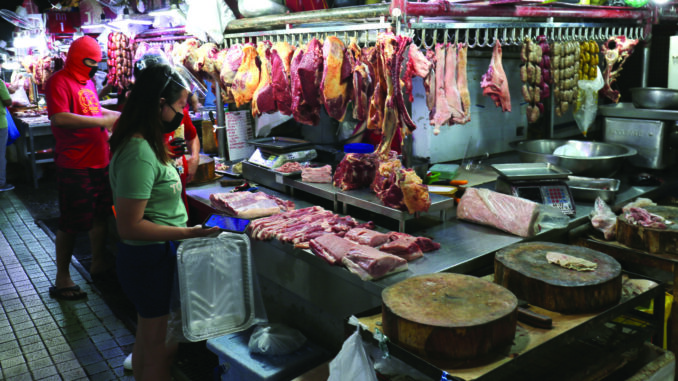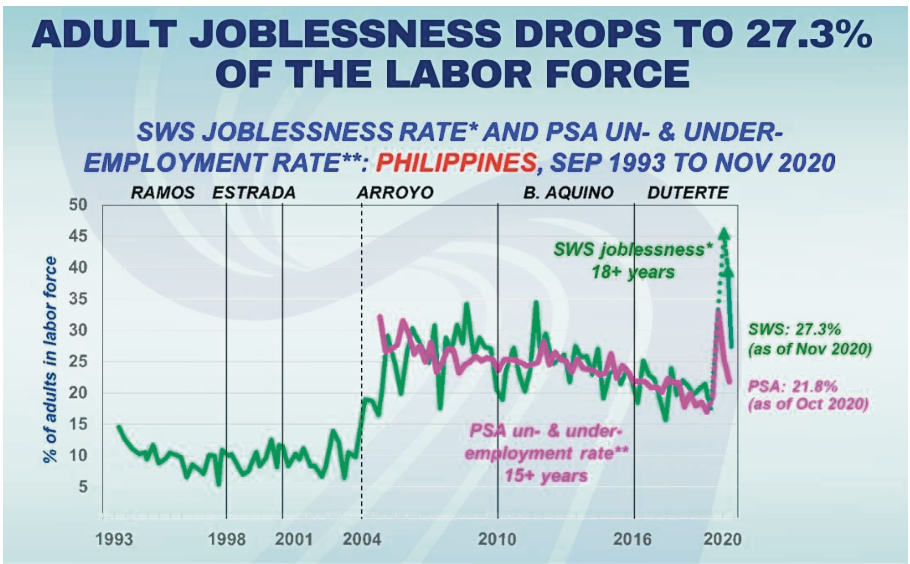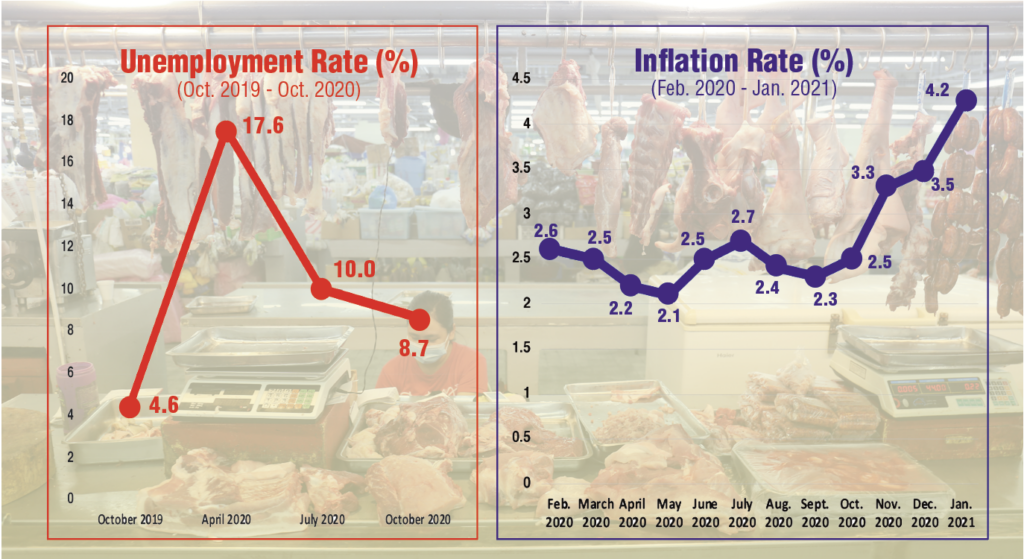
Imagine this: You are an ordinary worker. You lost your job because of the pandemic. So you have no income. You go to the market and you find that prices of nearly all food items have gone up –many by record highs. So you don’t buy anything. You go hungry. You are jobless, penniless, hungry. And there is no relief in sight.
US economist Arthur Okun designed a concept called “misery index”—a rising unemployment and a rising inflation results in what is called “misery” because the combination causes economic and social costs.
The Philippine Statistics Authority reported on Feb. 10 that the country’s headline inflation rate accelerated to 4.2% in January 2021, from 3.5% in the previous month (December).
This is the fastest inflation rate in two years since the 4.4% inflation recorded in January 2019.
The rate of increase in prices, what is called inflation, is the highest in two years. The country’s unemployment rate, hit a historic high of 17.6% in the second quarter of 2020. In 2019, unemployment hit a record low of 4.6%–meaning President Duterte actually solved joblessness, since a 4.6% unemployment is equivalent to full employment. But then the pandemic struck.
An inflation rate of 4.2% and an unemployment rate of 17.6% (one out of every six workers without work) would yield a misery index of 21.8—a level never seen in this country.
Fortunately, the unemployment rate has settled at 8.7% before 2020 had ended. Still, the Social Weather Stations estimates self-rated unemployment at 27.3% currently. So that puts the misery index at above 35.30—astronomically high.

Despite the higher inflation rate in January, the National Economic and Development Authority (NEDA) said that the inflation target for this year remains unchanged at 2% to 4%.
Food prices high
According to PSA, the faster inflation in January 2021 was mainly driven by the increase in the price indices for food items, particularly meat and vegetables. Food is 50% of a poor household’s expenditure.
The country’s pork supply has been decimated by half, thanks to the Asian Swine Flu (ASF) that has bankrupted Luzon’s once robust hog industry.
Now imagine this: You are an ordinary worker. You lost your job because of the pandemic. So you have no income. You go to the market and you find that prices of nearly all food items have gone up –many by record highs. So you don’t buy anything. You go hungry. You are jobless, penniless, hungry.
Food inflation accelerated to 6.6%, while non-food inflation remained unchanged from the previous month at 2.3%. Meanwhile, faster price adjustments were also recorded in restaurants, miscellaneous goods and services, and transport.

Swine flu outbreak
PSA said rising food inflation can be attributed to the outbreaks of African Swine Fever (ASF), additional logistics and transportation costs of sourcing pork to augment supplies throughout the country, the closed fishing season across several regions, and the damage in the countryside from typhoons and floods last year.
“Our priority right now is to ensure that food supply is adequate so that households affected by COVID-19 and the quarantines will not be doubly affected by the increase in food prices,” said Acting Socioeconomic Planning Secretary Karl Kendrick T. Chua.
In the interim, allowing more importation of key agricultural products, while adhering to strict safety protocols to prevent entry of contaminated products, will help augment supply and manage inflation.
The Committee on Tariff and Related Matters has endorsed the proposed increase in the minimum access volume (MAV) of pork and the temporary decrease in the most favored nation (MFN) tariff rates of pork and rice, subject to the proper process and investigation by the Tariff Commission. All these can increase the food supply and stabilize food prices.
DA’s four-pronged approach
The Department of Agriculture is implementing a four-pronged approach to increase swine supply through heightened swine production in the identified ASF-free areas. In particular, NEDA supports the Department of Agriculture’s proposal to increase the MAV allocation for pork imports and implement ‘special hog lanes’ or food highways in coordination with the Department of Interior and Local Government. These measures will help boost domestic supply and ensure the unhampered delivery of agricultural products across the country.
The Updated Philippine Development Plan 2017-2022 launched last week also details strategies to increase connectivity through infrastructure development and opening up the logistics sector to ensure access to staple goods.
Nevertheless, overall inflation remains manageable as we continue to reap the benefits of the Rice Tariffication Law.
“We passed the Rice Tariffication Law to address the rice shortage and related price hikes last 2018. As a result, rice prices decreased by around 10 pesos per kilo from its peak. In January, rice inflation was close to zero at only 0.1%. Just like before, the government continues to be proactive in addressing spikes in inflation as this affects the poor the most,” NEDA chief Chua said.
BSP version of inflation
Year-on-year headline inflation rose significantly to 4.2% in January, which was higher than the 3.5% in December and was above the Bangko Sentral ng Pilipinas’ monthly forecast of 3.3-4.1% for the month.
Core inflation, which excludes selected volatile food and energy items to depict underlying demand-side price pressures, edged higher to 3.4% in January from 3.3% in the previous month. On a month-on-month seasonally-adjusted basis, inflation increased slightly to 0.9% in January from 0.8% in December.
The higher inflation outturn was due mainly to faster price increases of selected key food items. Inflation for meat remained elevated as the African Swine Fever outbreak continued to adversely affect domestic supply.
Prices of fruits and vegetables increased
Year-on-year inflation for fruits and vegetables also increased, further contributing to the rise in food inflation. Fish inflation also went up as a result of reduced supply with the close of the fishing season. On the other hand, year-on-year non-food inflation held steady in January compared to the previous month. The elevated inflation figure in January is consistent with the BSP’s prevailing assessment of a transitory uptick in inflation in the first half of 2021, largely reflecting ongoing supply-side pressures as well as positive base effects.
Average inflation is nevertheless still projected to settle within the 2.0-4.0% target range over the policy horizon, particularly as direct measures are being pursued by the national government to address the availability of affected commodities.
READ FULL ARTICLE HERE:

